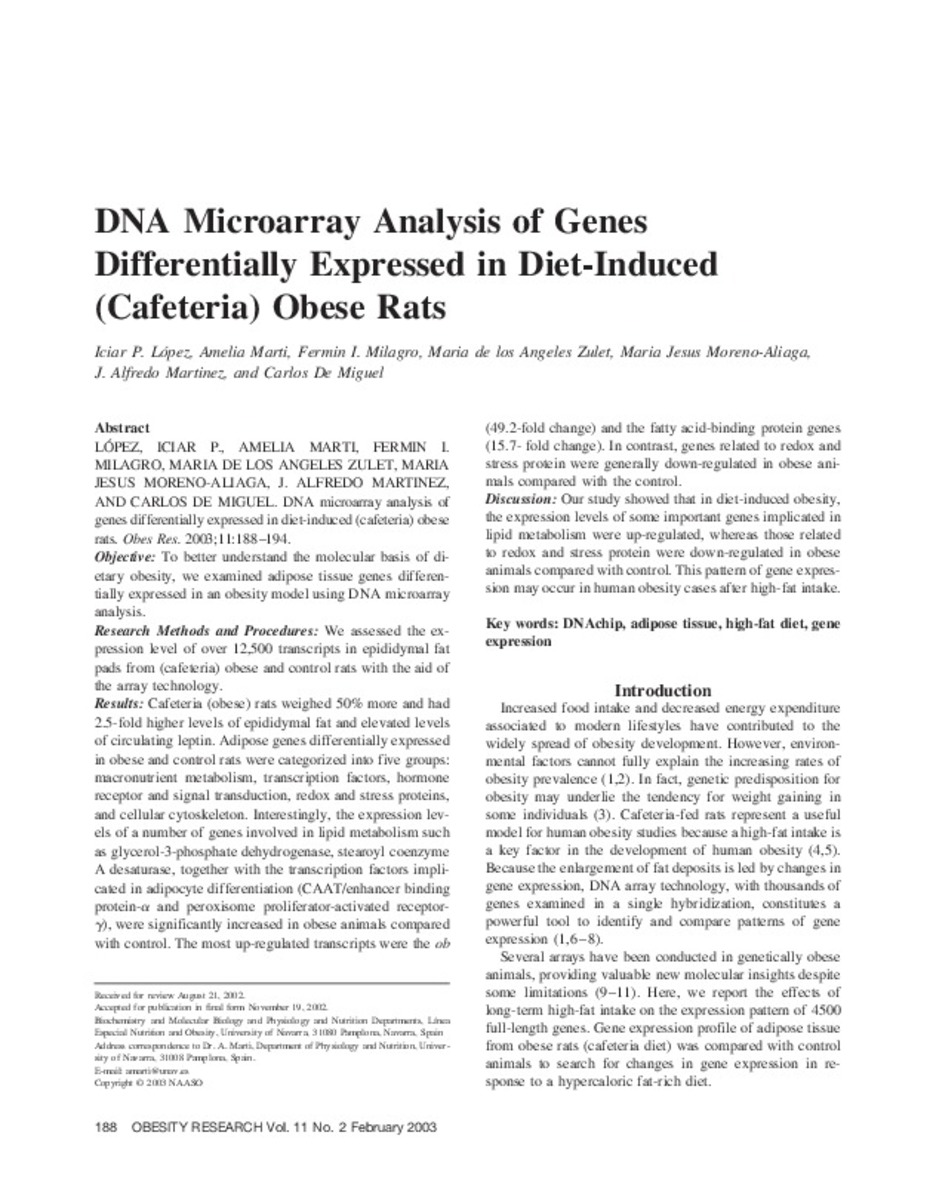Full metadata record
| DC Field | Value | Language |
|---|---|---|
| dc.creator | Lopez, I.P. (Iciar P.) | - |
| dc.creator | Marti-del-Moral, A. (Amelia) | - |
| dc.creator | Milagro-Yoldi, F.I. (Fermín Ignacio) | - |
| dc.creator | Zulet, M.A. (María Ángeles) | - |
| dc.creator | Moreno-Aliaga, M. J. (María Jesús) | - |
| dc.creator | Martinez, J.A. (José Alfredo) | - |
| dc.creator | Miguel-Vázquez, C. (Carlos) de | - |
| dc.date.accessioned | 2011-04-20T15:27:13Z | - |
| dc.date.available | 2011-04-20T15:27:13Z | - |
| dc.date.issued | 2003 | - |
| dc.identifier.citation | Lopez IP, Marti A, Milagro FI, Zulet Md Mde L, Moreno-Aliaga MJ, Martinez JA, et al. DNA microarray analysis of genes differentially expressed in diet-induced (cafeteria) obese rats. Obes Res 2003 Feb;11(2):188-194. | es_ES |
| dc.identifier.issn | 1071-7323 | - |
| dc.identifier.uri | https://hdl.handle.net/10171/17849 | - |
| dc.description.abstract | Objective: To better understand the molecular basis of dietary obesity, we examined adipose tissue genes differentially expressed in an obesity model using DNA microarray analysis. Research Methods and Procedures: We assessed the expression level of over 12,500 transcripts in epididymal fat pads from (cafeteria) obese and control rats with the aid of the array technology. Results: Cafeteria (obese) rats weighed 50% more and had 2.5-fold higher levels of epididymal fat and elevated levels of circulating leptin. Adipose genes differentially expressed in obese and control rats were categorized into five groups: macronutrient metabolism, transcription factors, hormone receptor and signal transduction, redox and stress proteins, and cellular cytoskeleton. Interestingly, the expression levels of a number of genes involved in lipid metabolism such as glycerol-3-phosphate dehydrogenase, stearoyl coenzyme A desaturase, together with the transcription factors implicated in adipocyte differentiation (CAAT/enhancer binding protein-alpha and peroxisome proliferator-activated receptor-gamma), were significantly increased in obese animals compared with control. The most up-regulated transcripts were the ob (49.2-fold change) and the fatty acid-binding protein genes (15.7- fold change). In contrast, genes related to redox and stress protein were generally down-regulated in obese animals compared with the control. Discussion: Our study showed that in diet-induced obesity, the expression levels of some important genes implicated in lipid metabolism were up-regulated, whereas those related to redox and stress protein were down-regulated in obese animals compared with control. This pattern of gene expression may occur in human obesity cases after high-fat intake. | es_ES |
| dc.language.iso | eng | es_ES |
| dc.publisher | North American Association for the Study of Obesity | es_ES |
| dc.rights | info:eu-repo/semantics/openAccess | es_ES |
| dc.subject | DNAchip | es_ES |
| dc.subject | Adipose tissue | es_ES |
| dc.subject | High-fat diet | es_ES |
| dc.subject | Gene expression | es_ES |
| dc.title | DNA microarray analysis of genes differentially expressed in diet-induced (cafeteria) obese rats. | es_ES |
| dc.type | info:eu-repo/semantics/article | es_ES |
| dc.relation.publisherversion | http://www.nature.com/oby/journal/v11/n2/full/oby200330a.html | es_ES |
Files in This Item:
Statistics and impact
Items in Dadun are protected by copyright, with all rights reserved, unless otherwise indicated.






